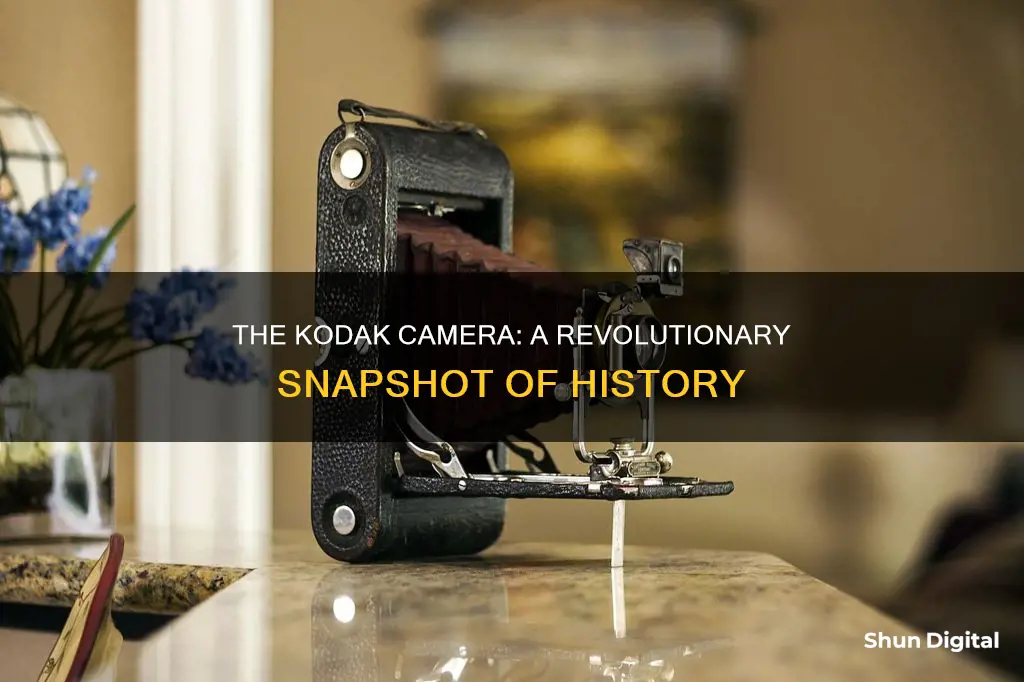
The Kodak camera, introduced in 1888, was the first successful roll-film hand camera. Invented by George Eastman, the camera was a simple box camera that came loaded with a 100-exposure roll of film. Eastman's marketing strategy, which emphasised the ease of using the camera, made photography accessible to millions of casual amateurs. The Kodak camera's distinctive circular snapshots also defined a new style of photography—informal, personal, and fun.
What You'll Learn

George Eastman's marketing strategy
- Simplification and Accessibility: Eastman's genius lay in simplifying photography, making it accessible to millions of casual amateurs without any professional training or technical expertise. The Kodak camera, introduced in 1888, was a simple box camera preloaded with a 100-exposure roll of film. After taking pictures, the entire camera was mailed back to the factory for developing and reloading.
- Advertising Campaign: To underscore the ease of using the Kodak camera, Eastman launched an innovative advertising campaign. His advertisements featured women and children operating the camera, emphasizing that anyone could use it. The memorable slogan, "You press the button, we do the rest," captured the simplicity of the process.
- Branding and Trademark: Eastman understood the power of branding and trademarks. He coined the term "Kodak," which was easy to remember and spell. The name quickly caught on, and "Kodak" became a noun, verb, and adjective, with terms like "Kodakers," "Kodakery," and "Kodaking" entering common American speech.
- Target Audience: Eastman recognized the importance of targeting children in his marketing strategy. He knew that children would keep photographers interested and ensure the longevity of his product. His advertisements often depicted family events, connecting his product with heartwarming moments.
- Design and Packaging: Eastman had an eye for design. His advertisements featured elegant line drawings and big block print, standing out from the busy and information-heavy ads of his time. He is also credited with introducing the bright yellow packaging that has become synonymous with Kodak products, making them instantly recognizable on store shelves.
- Innovation and Improvement: Eastman continuously sought to improve his product. He acquired competing companies, integrated marketing, production, and raw material supply, and focused on research and personnel development. He understood that maintaining high profits required a combination of product quality, reliability, and continuous innovation.
- Mass Production and Interchangeable Parts: Eastman's dream of a camera for the masses relied on mass production and interchangeable parts. The Kodak camera's 17 separate parts were designed to be easily interchangeable, making it more affordable and accessible to the general public.
The Pros and Cons of Deleting Raw Camera Files
You may want to see also

The Kodak camera's ease of use
The Kodak camera was a groundbreaking invention that revolutionised the world of photography. Introduced by George Eastman in 1888, the Kodak camera was the first successful roll-film hand camera. Its simplicity and ease of use made it accessible to amateur photographers, transforming photography into a popular pastime.
The Kodak camera was designed with a novice photographer in mind. Unlike earlier cameras that required complex technical knowledge and skills, the Kodak was a simple box camera that required no adjustments. To use the camera, the photographer simply had to arm the shutter by pulling a string, point the camera at the subject, and press the shutter release button. This simple process was effectively promoted through the catchy slogan, "You press the button, we do the rest."
The camera came preloaded with a 100-exposure roll of flexible film, eliminating the need for users to load individual glass-plate negatives for each exposure. After taking 100 pictures, the entire camera could be sent back to the factory for developing and reloading, making the process convenient and user-friendly.
The ease of use of the Kodak camera was further emphasised in its advertising campaigns. Eastman strategically featured women and children operating the camera, reinforcing the message that anyone could use it. The camera's simple design and marketing strategy successfully democratised photography, putting the power of capturing memories into the hands of everyday people.
The introduction of the Kodak camera marked a significant shift in the world of photography. It not only made photography accessible to amateurs but also shaped a new style of photography that was informal, personal, and fun. The Kodak camera's ease of use played a pivotal role in its success and impact on the history of photography.
Uploading Raw Camera Files: A Step-by-Step Guide
You may want to see also

The camera's impact on amateur photography
The introduction of the Kodak camera in 1888 was a pivotal moment in the history of amateur photography. The brainchild of George Eastman, the Kodak was a simple box camera that came pre-loaded with a 100-exposure roll of flexible film. Eastman's marketing strategy played a pivotal role in its success, as he understood the importance of simplifying the apparatus and processing for the consumer. Eastman's advertising campaigns featured women and children operating the camera, with the catchy slogan, "You press the button, we do the rest." This approach made photography accessible to millions of casual amateurs without any professional training or technical expertise.
Within a few short years, snapshot photography became a nationwide sensation in America. The term "Kodak" quickly entered the popular lexicon, with derivatives like "kodaking," "kodakers," and "kodakery" becoming part of everyday speech. Amateur photographers formed clubs, published magazines, and enthusiastically embraced this new form of visual expression. By 1898, just a decade after the Kodak's debut, an estimated 1.5 million roll-film cameras were in the hands of amateur photographers.
The Kodak camera's impact on amateur photography was profound. It democratised the medium, allowing anyone to capture and preserve everyday moments and memories. The circular snapshots produced by early Kodak cameras defined a new style of photography that was informal, personal, and fun. People began taking photographs to commemorate important life events, document travels, record family gatherings, and capture images of their children, pets, homes, and more. These snapshots often ended up in family albums, where they were carefully arranged and captioned, becoming cherished mementos.
The Kodak Brownie, introduced in 1900, further popularised photography with its simplicity and affordability. At just $1, it brought photography within financial reach of almost everyone, with film available for 15 cents a roll. The Kodak Brownie initiated a democratic shift in the accessibility of photography, ensuring that it was no longer just for professionals or the wealthy.
Charging Your 4K Dual Action Camera: A Quick Guide
You may want to see also

The camera's design and functionality
The design of the original Kodak camera was simple and user-friendly, a box-style camera that required no prior photographic knowledge or adjustments. It was a wooden rectangular prism, covered in smooth black leather, and small enough to be handheld and easily carried. It had a 57mm lens with good close-focusing capabilities, allowing photographers to focus on objects as close as 1.2 meters. The camera was loaded with a 100-exposure roll of flexible film, and after taking 100 pictures, the camera would be returned to the factory to be reloaded and for the film to be developed and printed.
The camera's functionality was straightforward. The photographer armed the shutter by pulling a string on the front right of the camera, pointed the camera at the subject, and then pressed the shutter release button on the side. There was no viewfinder, but two V-shaped lines on the top of the camera aided in aiming. After taking a photograph, a key on top of the camera was used to wind the film onto the next frame. The original Kodak camera was fitted with a rotating barrel shutter, which was set by pulling a string on top of the camera and operated by pushing the side button. However, this design proved expensive to manufacture and unreliable, so it was replaced by a simpler sector shutter in the No 1 Kodak model released the following year.
The Kodak camera's ease of use was emphasised in its marketing campaign, with advertisements featuring women and children operating the camera. The slogan "You press the button, we do the rest" emphasised the simplicity of the camera system, and it soon entered the public lexicon.
Alkaline Batteries: How Long Will Your Camera Run?
You may want to see also

The company's decline and bankruptcy
The Eastman Kodak Company, commonly known as Kodak, is an American public company that has historically focused on film photography and related products. Despite its early success and dominance in the industry, Kodak faced a decline in the late 1990s and eventually filed for bankruptcy protection in 2012. This decline can be attributed to several factors, including missed opportunities, strategic failures, and a reluctance to embrace digital technology.
One of the main reasons for Kodak's decline was its failure to recognize and adapt to the shift from film to digital photography. Kodak invented the first self-contained digital camera in 1975, but the company's management did not see digital photography as a disruptive technology. Instead, they chose to use digital primarily to improve the quality of their film products. This strategic failure resulted in Kodak missing out on the opportunity to lead the digital image processing market.
In 1996, Kodak introduced the Advantix Preview film and camera system, which was a digital camera that still used film and emphasized print. This product flopped as consumers saw no benefit in paying for film and prints when using a digital camera. This was a significant misstep for Kodak, as they had invested more than $500 million in its development and launch.
Another factor contributing to Kodak's decline was the increasing competition from rival companies, particularly Fujifilm. Fujifilm entered the US market in the 1980s with lower-priced film and supplies, aggressively cutting into Kodak's market share. By 1997, Fujifilm had captured 17% of the market, and their specialty transparency films competed directly with Kodak's professional products. Despite Kodak's attempts to diversify and cut costs, they struggled to keep up with the competition.
Additionally, Kodak made several unsuccessful attempts to diversify its chemical operations. In 1988, they purchased Sterling Drug for $5.1 billion but soon realized that the two businesses were not compatible, and they ended up selling Sterling for about half the original purchase price. This, along with other failed diversification efforts, resulted in significant losses for the company.
In January 2012, Kodak filed for Chapter 11 bankruptcy protection. The company emerged from bankruptcy in September 2013, having restructured and exited several businesses. Kodak's decline and bankruptcy had a significant impact on the Rochester area, contributing to high poverty rates and economic losses.
Charging the Kami Doorbell Camera: A Step-by-Step Guide
You may want to see also
Frequently asked questions
The Kodak camera, introduced in 1888, was the first successful roll-film hand camera. It was simple to use and affordable, and it came pre-loaded with enough film for 100 exposures. This made photography accessible to amateurs, creating a craze for snapshot photography.
The Kodak camera was invented by George Eastman, an American inventor and businessman. He founded the Eastman Kodak Company, which became one of the world's largest film and camera manufacturers.
The Kodak camera was a box-style camera with a fixed-focus lens. It had a pull-string to set the shutter and a button to release it. After taking 100 pictures, the camera was mailed back to the factory for developing and reloading.
The Kodak camera revolutionized photography by putting the power of photography into the hands of amateurs. It sparked a national craze for snapshot photography and led to the formation of amateur photography clubs and magazines.
The key features of the Kodak camera included its ease of use, with a simple slogan of "You press the button, we do the rest". It was also affordable, costing $25 with a pre-loaded film roll and a leather carrying case. The camera produced distinctive circular snapshots, creating a new style of informal and personal photography.







